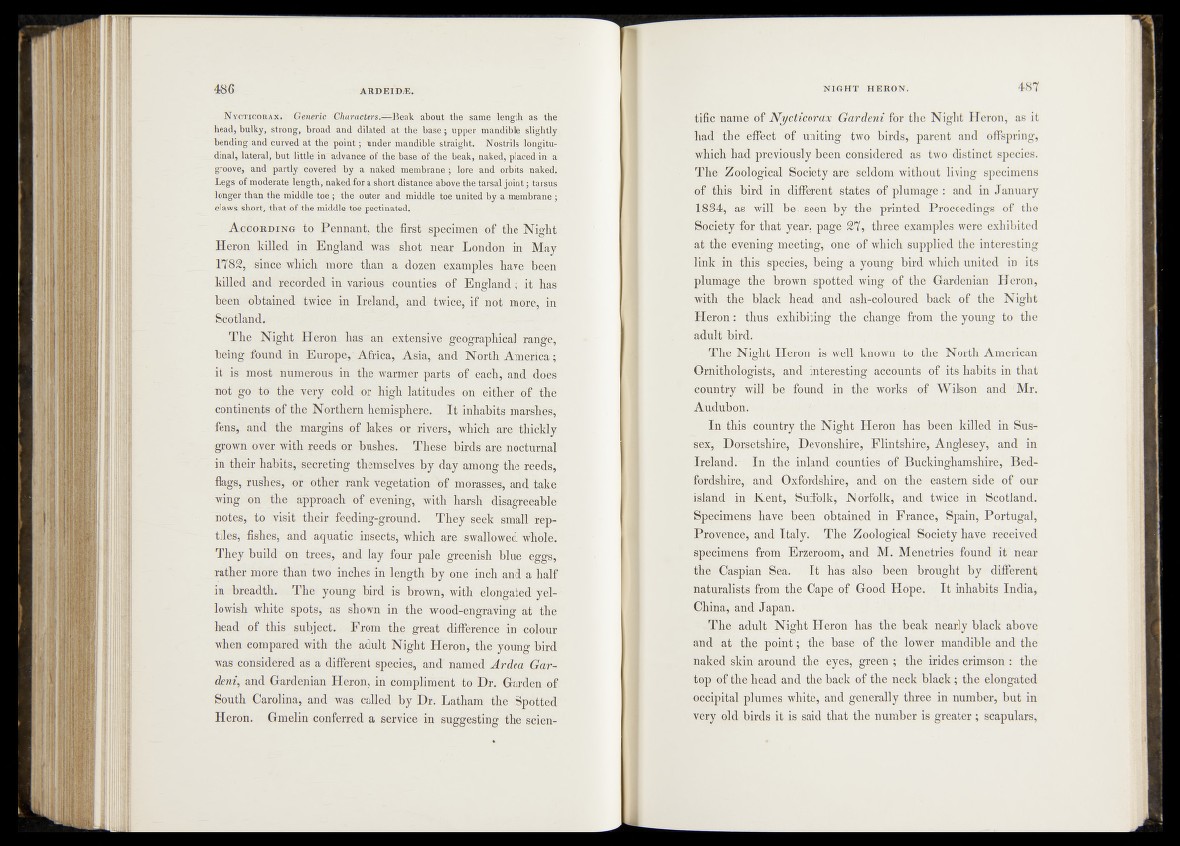
Nycticorax. Generic Characters.—Ipeak about the same „length as the
head, bulky, strong,-broad and dilated at the base; upper-,mandible ^lightly*
bending and curved at the point; under mandible“ straight. ' Nostrils longitudinal,
lateral, but little itr advance of the base of-the beak, naked, placedin a
groove; and partly covered by a naked membrane ; Jpre and orbits naked.
Legs of moderate length, naked for a short, distance above the tarsal joint; tarsus
longer than the middle toe; the outer and middle toe united by'U.membrane;
claws short, that of the middle toe pectinated.
A ccording to Pennant, the first- specimen' of the Night
Heron hilled in England was shot near London. ||§|May
1782, since which; more than a dozen. exampl^.-^a|^been
killed and recorded in various counties of England; it has
been obtained twice in Ireland, andj twice, if not more:;, fib.'”
Scotland.
The Night Heron has an extensive geographical range,
being found in Europe,; Africa/Asia, and North America;
it is most numerous in the. warmer parts of each", and. does
not go to: .the very; Oold or high latitud#5hn/leithe& of the
continents of the Northern hemisphere. I t inhabits marsh#/
fens, and the margins of lakes or fivefsf;?w-hich are thickly
grown over with reeds or -bushes. These birds are nocturnal
in their habits, secreting themselves by day amo'ng the-rfeeds,
flags, rushes, or other rank vegetation of morasses, and take
wing on the approach of evening, with ’harsh disagreeable
notes, to visit their feeding-ground. They seek* small reptiles,
fishes, and aquatic insects, which are swallowed whole.
They build on trees, and lay four pale greenish" blue eggs,
rather more than two inches in length by one inch and a half
in breadth. The young bird is brown, with elongated y e llowish
white spots, as shown in the wood-engraving at the
head of this subject. From the great difference in colour
when compared with the adult Night Heron, the young bird
was considered as a different species, and' named Ardea Gar-
deni, and Gardenian Heron, in compliment, to Dr. Garden of.
South Carolina, and was called by Dr. Latham the Spotted
Heron. Gmelin conferred a service in suggesting the scientific
name of Nycticorax Gar deni for the Night Heron, as it
had theWffe'ct Vf. uniting two birds, parent and offspring,
which had previously been considered as two distinct species.
The Zoological 'Society are seldom without living specimens
of fhis birjl in 'different states of plumage : and in January
1884, as will be, seen hy&the printed Proceedings of the
Society for That year, page 27, three examples were exhibited
at the evening meeting;:.one' of which supplied the interesting
link in f^i||,''sp|,cies; being a young bird which united in its
plumage the brown spotted- wing- of the Gardenian Heron,
with the -black the§d^ and« ash-coloured back of the Night
Heron: thus exhibiting the change from the young to the
adult bird.
tHEfee\Might Herdn-'is well known to the North American-
Ornithologists, and interesting- accounts of its habits in that
country will be »-found in the . works of Wilson and Mr.
Audubon.
In .this country the Night Heron has been- killed in Sussex,
Dorsetshire,-^ Devonshire, Flintshire, Anglesey,- and in
Ireland. In the inland counties of Buckinghamshire,. Bedfordshire,,
and Oxfordshire, and on the eastern side of our
island in Kent, ^Suffolk, Norfolk,' and twice in Scotland.
Specimens havetbefen" obtained in France, Spain, Portugal,
Provence, and Italy. .. The Zoological Society have received
specimens from Erzeroom, and M. Menetries found it near
the «Caspian Sea. I t has also been brought by different
naturalists from the Cape of Good Hope. It inhabits India,
China, and Japan.
The adult -Night Heron has the beak nearly black above
and at the point ; the base of the lower mandible and the
naked skin around the i eyes-, green ; the irides crimson : the
top of the head and the back of the neck black; the elongated
occipital plum eg white, and generally three in number, but in
very old birds it is said that the number is greater; scapulars,